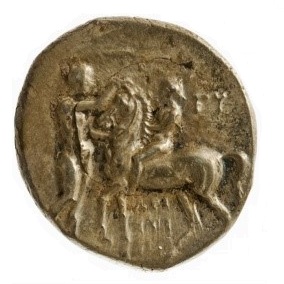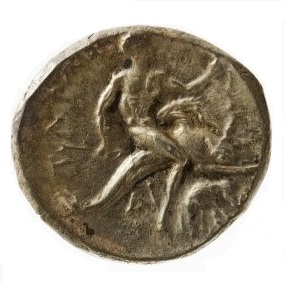Title: Didrachmon of Taras (Tarentum) - 1985.02
Acquisition number: 1985.02
Author or editor: Douglas Kelly
Culture or period: Hellenistic.
Date: c. 281-272 BC.
Material: Metal - Silver
Object type: Coins - Greek
Dimensions: 22mm (w)
Origin region or location: Italy
Origin city: Taras (Tarentum)
Display case or on loan: 5
Keywords: Coin, Greek, didrachmon, Sicily, Taras, Phalanthos, Pyrrhos of Epirus
A.J. Evans, ‘The “Horsemen” of Tarentum, The Numismatic Chronicle 9 (1889), 1-228.
O. Ravel, The Collection of Tarentine Coins Formed by M.P. Vlasto (London, 1947; repr. edn Chicago, Obol International, 1977).
K.N. Rutter (ed.), Historia numorum: Italy (London, The British Museum, 2001), 1000.
Classical Numismatic Group Auction, 155905.
1985.02
Didrachmon of Taras (Tarentum)
Silver 6.52 g. 22 mm. c. 281-272 BC.
Obv.: Naked man standing r., crowning a horse pacing l., ridden by naked boy. PY to right, API/. . . .
Rev.: Youthful male seated on a dolphin r., elephant to right. To left ΤΑΡΑΣ (Taras). AI and elephant below.
From c. 400 BC onwards, Taras (Roman Tarentum), produced large issues of silver coins, known today as ‘horsemen’ after the image that appears on the obverse.
The nudity of the figures, the act of crowning, and the youth of the rider (racehorse jockeys were boys) suggests that the reference of this scene is to victory in the highly esteemed and popular sport of horse-racing at inter-city festivals (cf. 1967.24).
Taras was a local god of the river on which the city of Taras stood. Greeks identified him as a son of the sea-god Poseidon; he had an important cult in Taras. The leader of the first settlement at Taras in 706 BC, Phalanthos, was worshipped as a hero after his death, as was usual with the founders of colonies. At an early stage his cult was associated with that of Taras and over time the two figures became identified. It is uncertain whether the dolphin-rider on the obverse is Taras, Phalanthos, or, confusingly, both.
In 282 BC, at war with the Roman Republic in the south of Italy, Taras called in the leading Greek general and adventurer of the day, Pyrrhos of Epirus. Pyrrhos’s army included twenty of the Hellenistic age’s latest piece of military technology, the war-elephant. The little elephant on the reverse is held to refer to these.
Paying for Pyrrhos’s professional army required an increased output of coinage by Taras. A new weight-standard was applied, with the Tarentine drachma reduced from c. 7.9 g. to c. 6.5 g., bringing it into line, so it seems, with the weight of the drachma current amongst the Greek cities of Italy.
A.J. Evans, ‘The “Horsemen” of Tarentum, The Numismatic Chronicle 9 (1889), 1-228.
O. Ravel, The Collection of Tarentine Coins Formed by M.P. Vlasto (London, 1947; repr. edn Chicago, Obol International, 1977).
K.N. Rutter (ed.), Historia numorum: Italy (London, The British Museum, 2001), 1000.
Classical Numismatic Group Auction, 155905.

